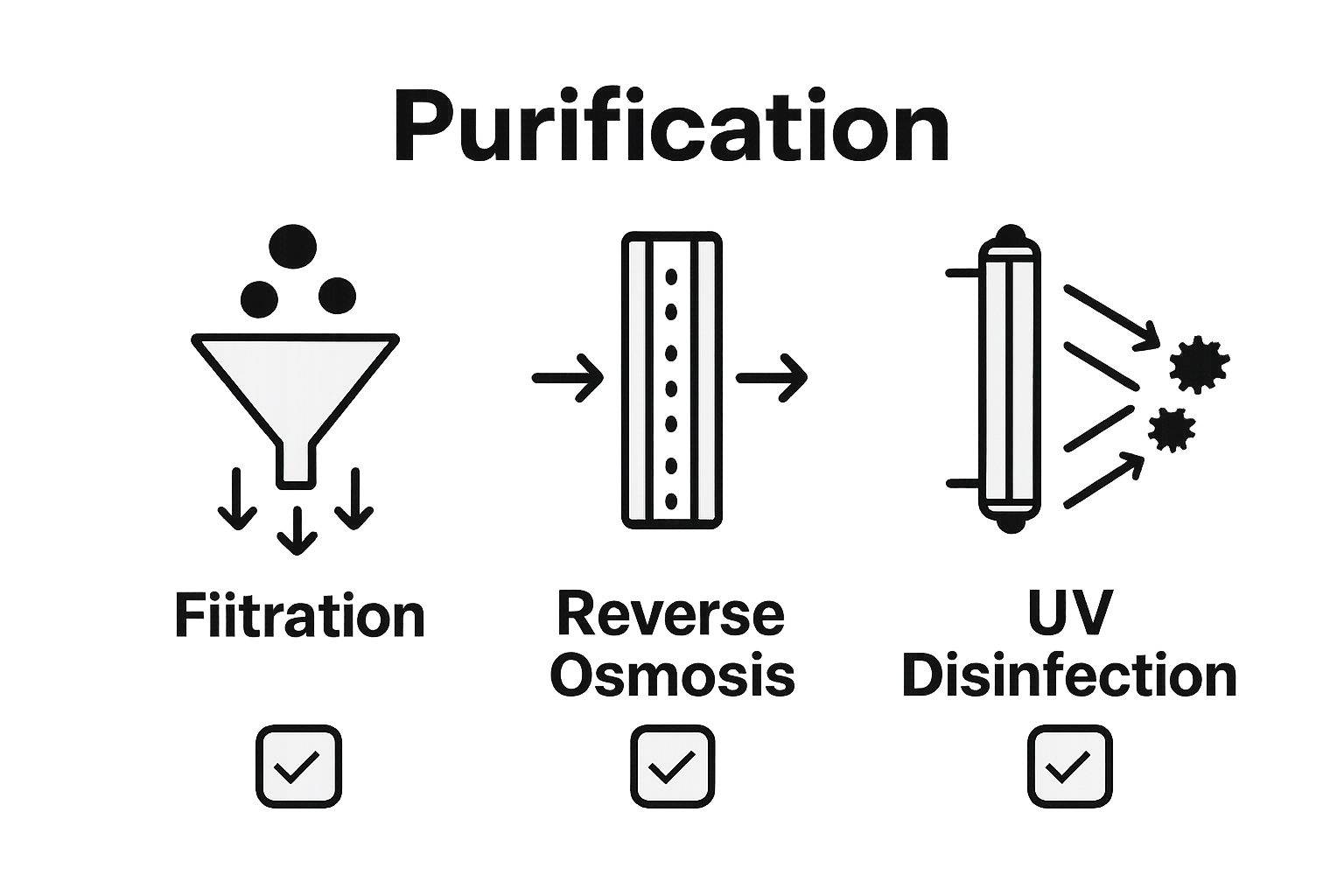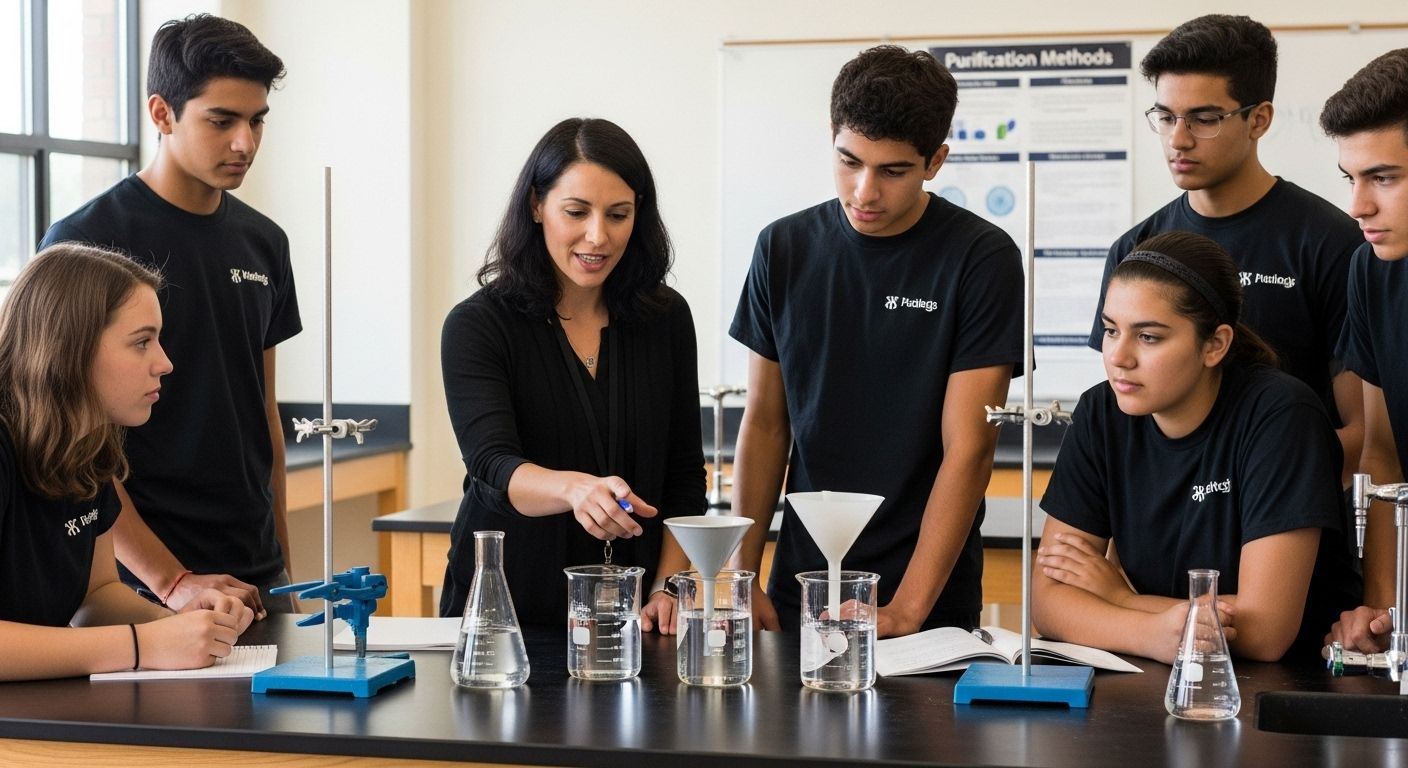Uncategorized
What is Water Purification? Understanding Its Importance
Clean water is something most people don’t give a second thought. Yet more than 2 billion people worldwide lack access to safely managed drinking water, according to the World Health Organization. Most folks think water purification is just about basic filtering, but the reality is far more complex. Purification uses science and technology in ways that go far beyond what the eye can see.
Table of Contents
- Defining Water Purification: What Is It Really?
- The Importance of Water Purification for Health and Safety
- Mechanisms of Water Purification: How It Works
- Key Types and Methods of Water Purification
- Real-World Applications: Water Purification in Everyday Life
Quick Summary
| Takeaway | Explanation |
|---|---|
| Water purification is essential for health. | It transforms contaminated water into safe drinking water, eliminating health risks. |
| Multiple methods ensure comprehensive cleaning. | Techniques like filtration, chemical treatment, and biological purification target various contaminants effectively. |
| Home systems offer accessible solutions. | Domestic water treatment systems can address specific drinking water safety concerns, improving household water quality. |
| Water purification prevents serious diseases. | Effective treatment protects communities from waterborne illnesses caused by hidden pathogens and pollutants. |
| Advanced technologies enhance effectiveness. | Methods like reverse osmosis and UV disinfection provide thorough purification for diverse applications. |
Defining Water Purification: What Is It Really?
Water purification represents a critical process that transforms potentially contaminated water into safe, consumable liquid by removing harmful substances, microorganisms, and chemical pollutants. The World Health Organization emphasizes that clean water is fundamental to human health, making water purification an essential practice for protecting public wellness.
The Core Concept of Water Purification
At its most fundamental level, water purification is a comprehensive treatment method designed to eliminate impurities and make water safe for human consumption. This process involves multiple sophisticated techniques that target different types of contaminants, ensuring water meets stringent health and safety standards. The goal is not just basic filtration, but comprehensive decontamination that addresses biological, chemical, and physical impurities.
How Water Purification Works
The water purification process typically involves several critical stages that work synergistically to clean water:
- Physical Filtration: Removes larger particles and sediments through mechanical barriers
- Chemical Treatment: Neutralizes harmful microorganisms and chemical contaminants
- Biological Purification: Eliminates microscopic organisms like bacteria and viruses
Understanding these mechanisms helps explain why water purification is more than a simple filtering process. It is a complex scientific approach that ensures water quality through methodical, multi-stage treatment.
To clarify the differences between core water purification methods discussed, the following table compares their targeted contaminants and primary mechanism.
| Method | Targeted Contaminants | Primary Mechanism |
|---|---|---|
| Physical Filtration | Sediment, large particles, some chemicals | Uses physical barriers (membranes, carbon) to trap impurities |
| Chemical Treatment | Microorganisms, chemical pollutants | Adds chemicals to neutralize or remove contaminants |
| Biological Purification | Bacteria, viruses, organic matter | Uses biological processes or organisms to break down impurities |
| Reverse Osmosis | Dissolved solids, microscopic contaminants | Forces water through ultrafine membranes |
| UV Disinfection | Bacteria, viruses, other microorganisms | Uses ultraviolet light to inactivate microbes |
The Importance of Water Purification for Health and Safety
The Centers for Disease Control and Prevention highlights the critical connection between water quality and human health, underscoring why water purification is far more than a technical process. It represents a fundamental public health intervention that protects communities from potentially devastating waterborne diseases and long term health risks.
Protecting Against Hidden Health Threats
Water sources can harbor numerous invisible contaminants that pose significant health risks. These include microscopic bacteria, viruses, parasites, chemical pollutants, and heavy metals that cannot be detected by simple visual inspection. Waterborne pathogens can cause severe illnesses ranging from mild gastrointestinal disorders to life threatening conditions like cholera, dysentery, and hepatitis. Water purification serves as a critical barrier against these invisible dangers.
Key Health Benefits of Water Purification
The health advantages of comprehensive water purification extend far beyond immediate disease prevention. Proper water treatment provides multiple protective benefits:
- Removal of Toxic Chemicals: Eliminates harmful industrial and agricultural chemical residues
- Microbiological Safety: Neutralizes disease causing microorganisms
- Heavy Metal Reduction: Filters out dangerous metallic contaminants like lead and mercury
Consumers seeking comprehensive protection should explore advanced water purification strategies to understand the full spectrum of potential water treatment approaches. By investing in robust water purification systems, individuals can safeguard their health and ensure access to clean, safe drinking water.
Mechanisms of Water Purification: How It Works
The National Sanitation Foundation explains that water purification is a sophisticated scientific process involving multiple interconnected technologies designed to transform contaminated water into safe, consumable liquid. Understanding these mechanisms reveals the complexity behind what appears to be a simple filtration process.
Fundamental Purification Technologies
Water purification employs several advanced technologies that work in concert to eliminate contaminants. These technologies target different types of impurities through precise, scientifically engineered approaches. Physical, chemical, and biological methods are strategically combined to create comprehensive water treatment systems that address a wide range of potential contamination scenarios.
Key Purification Methods
The primary mechanisms of water purification include advanced techniques that systematically remove harmful substances:
- Filtration: Uses physical barriers like membranes and activated carbon to trap particles and chemical compounds
- Reverse Osmosis: Pushes water through ultrafine membranes to remove dissolved solids and microscopic contaminants
- UV Disinfection: Utilizes ultraviolet light to neutralize bacteria, viruses, and other microorganisms
Those interested in understanding more technical details can explore advanced water purification methods that provide deeper insights into these sophisticated processes. Each method offers unique advantages, ensuring comprehensive water treatment that goes beyond simple surface level cleaning.

Key Types and Methods of Water Purification
The Environmental Protection Agency identifies multiple sophisticated approaches to water purification that address different contamination challenges. Each method represents a specialized strategy for transforming potentially unsafe water into clean, consumable liquid through targeted technological interventions.
Classification of Water Purification Methods
Water purification technologies can be broadly categorized based on their specific mechanisms and the types of contaminants they target. These classifications range from physical filtration techniques to advanced chemical and biological treatment processes. The complexity of these methods reflects the intricate nature of water contamination and the need for comprehensive, multi-layered purification strategies.
Primary Water Purification Approaches
Water treatment professionals utilize several key purification methods to ensure water safety and quality:
- Physical Filtration: Removes solid particles through membrane and granular filtration techniques
- Chemical Disinfection: Uses chlorination, ozonation, and other chemical processes to neutralize harmful microorganisms
- Biological Treatment: Employs natural microbial processes to break down organic contaminants
- Advanced Membrane Technologies: Includes reverse osmosis and ultrafiltration for removing microscopic impurities
Discover comprehensive water purification strategies that can help you understand the intricate science behind transforming contaminated water into a safe, healthy resource. Each method plays a crucial role in ensuring water quality and protecting public health.

Real-World Applications: Water Purification in Everyday Life
The World Health Organization emphasizes that water purification is not just a technical process but a critical intervention that directly impacts human health and quality of life. From residential settings to industrial applications, water purification technologies play an essential role in protecting communities and supporting various daily activities.
The table below summarizes the main sectors where water purification is applied, highlighting their specific water quality concerns and purification priorities.
| Sector | Water Quality Concerns | Purification Priority |
|---|---|---|
| Residential | Chlorine, sediment, heavy metals, microbes | Safe drinking water and household use |
| Healthcare Facilities | Microbes, sterile requirements | Sterile water for procedures and patient care |
| Food/Beverage Industry | Chemical residues, microbes | Quality control and regulatory compliance |
| Agriculture | Contaminants, heavy metals | Safe irrigation and crop protection |
| Industrial Manufacturing | Minerals, contaminants, scaling agents | Equipment protection and product quality |
Residential Water Treatment Solutions
Homeowners have multiple options for implementing water purification in their living spaces. Domestic water treatment systems range from simple pitcher filters to sophisticated under-sink and whole-house filtration units. These systems address common household water quality concerns such as removing chlorine, sediment, heavy metals, and potential microbial contaminants that might compromise drinking water safety.
Diverse Applications Across Different Sectors
Water purification technologies extend far beyond residential use, serving critical functions in multiple domains:
- Healthcare Facilities: Ensuring sterile water for medical procedures and patient care
- Food and Beverage Industry: Maintaining strict water quality standards for production
- Agricultural Irrigation: Removing contaminants that could harm crop development
- Industrial Manufacturing: Protecting sensitive equipment from mineral buildup and contamination
Explore advanced home water purification strategies to understand how these technologies can be integrated into your daily life, protecting your health and improving overall water quality across various settings.
Ready to Experience True Water Purification at Home?
You just learned how vital it is to remove invisible threats from your water and keep your family safe. Maybe you’re worried about unseen bacteria or the chemical contaminants mentioned in the article. Or perhaps you want peace of mind knowing every drop from your tap is truly clean. Coway’s advanced water purifiers put health and quality first with powerful multi-stage filtration, UV technology, and trusted reliability. When it comes to protecting your loved ones, settling for basic filtration is not enough. See how our solutions address the challenges you read about in our article and discover products backed by research and proven results.

Shop now at https://cowayswaterpurifier.com for the latest water purification systems. Take the next step toward safer, better-tasting water every day. Don’t wait until you notice a problem. Make a proactive choice to protect your home and well-being. Visit our Uncategorized articles for more guidance or start exploring your options today at our main page.
Frequently Asked Questions
What is water purification?
Water purification is a process that transforms potentially contaminated water into safe, consumable liquid by removing harmful substances, microorganisms, and chemical pollutants.
Why is water purification important for health?
Water purification is crucial for protecting public health as it eliminates invisible contaminants that can cause waterborne diseases and long-term health risks.
What methods are commonly used in water purification?
Common water purification methods include physical filtration, chemical treatment, biological purification, reverse osmosis, and UV disinfection, each designed to target specific types of contaminants.
How does water purification benefit everyday life?
Water purification plays a vital role in residential settings by ensuring safe drinking water and is essential in sectors like healthcare, food production, agriculture, and industrial manufacturing to maintain water quality standards.
Recommended
- 7 Effective Water Purification Methods for Your Home
- What is Water Filtration? Understanding Its Importance
- What is Under-Sink Water Purifier? Understanding Its Importance
- 8 Essential Water Purification Best Practices for Health
- Why a Water Filtration System is Essential – 8th Bend Plumbing Heating and Cooling
- What is Deep Cleaning? Understanding Its Importance

